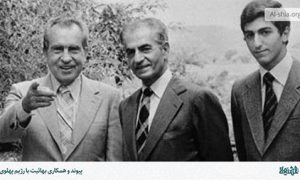We know that some campaigns were don against Bahaism after Mordad 28th coup:
۱) The background of fighting: Prior Mordad 28th coup, fighting against Bahaism were done in two levels: The elite and democratic. So, associations, groups, various organizations were fighting against Bahaism led by clergymen.
The characteristics of those campaigns:
-They were political
– mosques and religious panels were the centers
– The campaigns weren’t limited to a special person or group, so their governmental management was difficult.
The Supreme Shia leader, Ayatollah Brougerdi (p.4.) was the head of the campaign and he had put the Shah under pressure to limit, excommunicate and vanish the Bahaism organization. The Shah was also promising him to limit Bahaism.
۲) After the coup:
Coincided with the coup, Hojjatiyeh association was born and at the same time, all groups, parties, organizations, and the associations of 1320s were collapsed.
Meantime, even the Islamic advertisements of Dr. Shahab Pour was destroyed although it was nationwide, organized having thousand seasoned, skillful and educated job force.
۳) Fighting of association:
After destroying the dome of the Baha’is, Hazirtul Qods in Tehran city, the new phase of campaigning against Bahaism started. This time, Hojjatiyeh association entered into the arena. Campaigning in this period of time can be introduced as follows:
۱) It got technical and specialized
۲) It was transferred to the elite level
۳) People were left aside to fight
۴) masques and religious panels weren’t the centers of fighting
۵) It was taken over by the clergymen
۶) One of the most important sources of social mobilization was gradually destroyed.
۷) The campaign was changed into merely scientific and non-political challenge.
۸) Social riots caused by people’s dispute with the Baha’is were prevented.
۹) The campaign was just limited to a known organization. organization just
۱۰) Behaviors, programs and tactics of defined campaign wan predicted and managed.
۱۱) The end goal of the campaign was the destruction of non-defined Bahaism.
۱۲) This Campaign wasn’t considered as the end goal of the regime (growing Bahaism), but it was helpful.
۱۳) Running this campaign was sending a message to the public thought that the Shah agreed fighting against Bahaism, so Shah’s religious popularity was increased.
۱۴) Hojjatiyeh association was perking as a formation which was scientific beaning an exclusive religious discourse (different from clergymen).
Consequently, we can observe that the deviant cult of Baha’ism which was influential in all pillars of Pahlavi government possessed all areas of power of a democratic campaign against Baha’ism and didn’t let the scholars have a democratic campaign using a complicated plan. Eventually, this Colonial cult penetrated into all pillars of Pahlavi government and dominated and this dominance ended by the victory the supreme revolution in Iran headed by late Imam Khomeini (P.H.).
– Source: moghadasnama@






